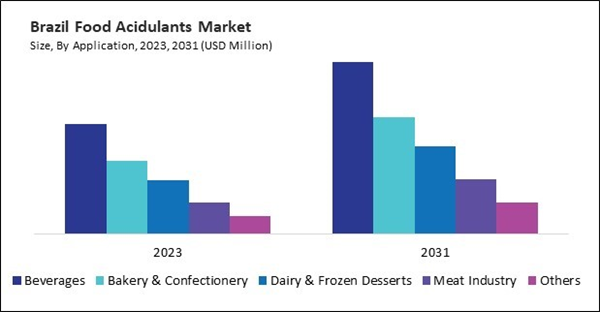Phosphoric acid, a vital component in the food acidulants market, finds widespread use across various food and beverage applications. Primarily known for its ability to enhance flavor profiles, it adds acidity and tartness to products while balancing sweetness. Commonly employed in carbonated beverages like colas, phosphoric acid not only imparts a distinct tangy taste but also acts as a pH stabilizer. Its versatility extends to processed foods, jams, jellies, and snacks, where it serves as a flavoring agent. Therefore, the Brazil market consumed 18.00 tonnes of phosphoric acid in 2023.
The Brazil market dominated the LAMEA Food Acidulants Market by Country in 2023, and is forecast to continue being a dominant market till 2031; thereby, achieving a market value of $198.1 Million by 2031. The Argentina market is showcasing a CAGR of 8.2% during (2024 - 2031). Additionally, The UAE market would register a CAGR of 7% during (2024 - 2031).
The growing popularity of plant-based and vegan diets has led to a surge in demand for food products free from animal-derived ingredients. Acidulants derived from plant sources are gaining traction as suitable alternatives to synthetic additives, offering vegan-friendly and cruelty-free options for food manufacturers.
Likewise, acidulants are increasingly being recognized for their functional properties beyond flavor enhancement. For example, some acidulants exhibit antioxidant properties that contribute to the shelf life and stability of food products. There is growing interest in exploring the functional benefits of acidulants and incorporating them into formulations targeting specific health benefits, such as digestive health or immune support.
Saudi Arabia is swiftly working to diversify its economy under its Vision 2030 strategy, which intends to reduce its reliance on oil and foster the growth of other industries, such as food processing. This initiative drives investment in food processing infrastructure, leading to increased demand for food acidulants essential for product quality, preservation, and flavor enhancement. The rapid urbanization in Saudi Arabia is leading to significant changes in dietary habits, with a higher consumption of processed and convenience foods. Food acidulants are crucial in these products for maintaining freshness, flavor, and stability, driving their demand as the processed food sector expands. Therefore, the expansion of the region's food processing industry is driving the market's growth.
List of Key Companies Profiled
- Tate & Lyle Plc
- Brenntag SE
- Univar Solutions, Inc.
- Archer Daniels Midland Company
- Jungbunzlauer Suisse AG
- Cargill, Incorporated
- Corbion N.V.
- Bartek Ingredients Inc. (TorQuest Partners)
- FBC Industries Inc.
- Hawkins Watts Limited
Market Report Segmentation
By Application< (Volume, Tonnes, USD Billion, 2020-2031)- Beverages
- Bakery & Confectionery
- Dairy & Frozen Desserts
- Meat Industry
- Others
- Citric Acid
- Acetic Acid
- Lactic Acid
- Phosphoric Acid
- Malic Acid
- Others
- Brazil
- Argentina
- UAE
- Saudi Arabia
- South Africa
- Nigeria
- Rest of LAMEA
Table of Contents
Companies Mentioned
- Tate & Lyle Plc
- Brenntag SE
- Univar Solutions, Inc.
- Archer Daniels Midland Company
- Jungbunzlauer Suisse AG
- Cargill, Incorporated
- Corbion N.V.
- Bartek Ingredients Inc. (TorQuest Partners)
- FBC Industries Inc.
- Hawkins Watts Limited
Methodology

LOADING...









